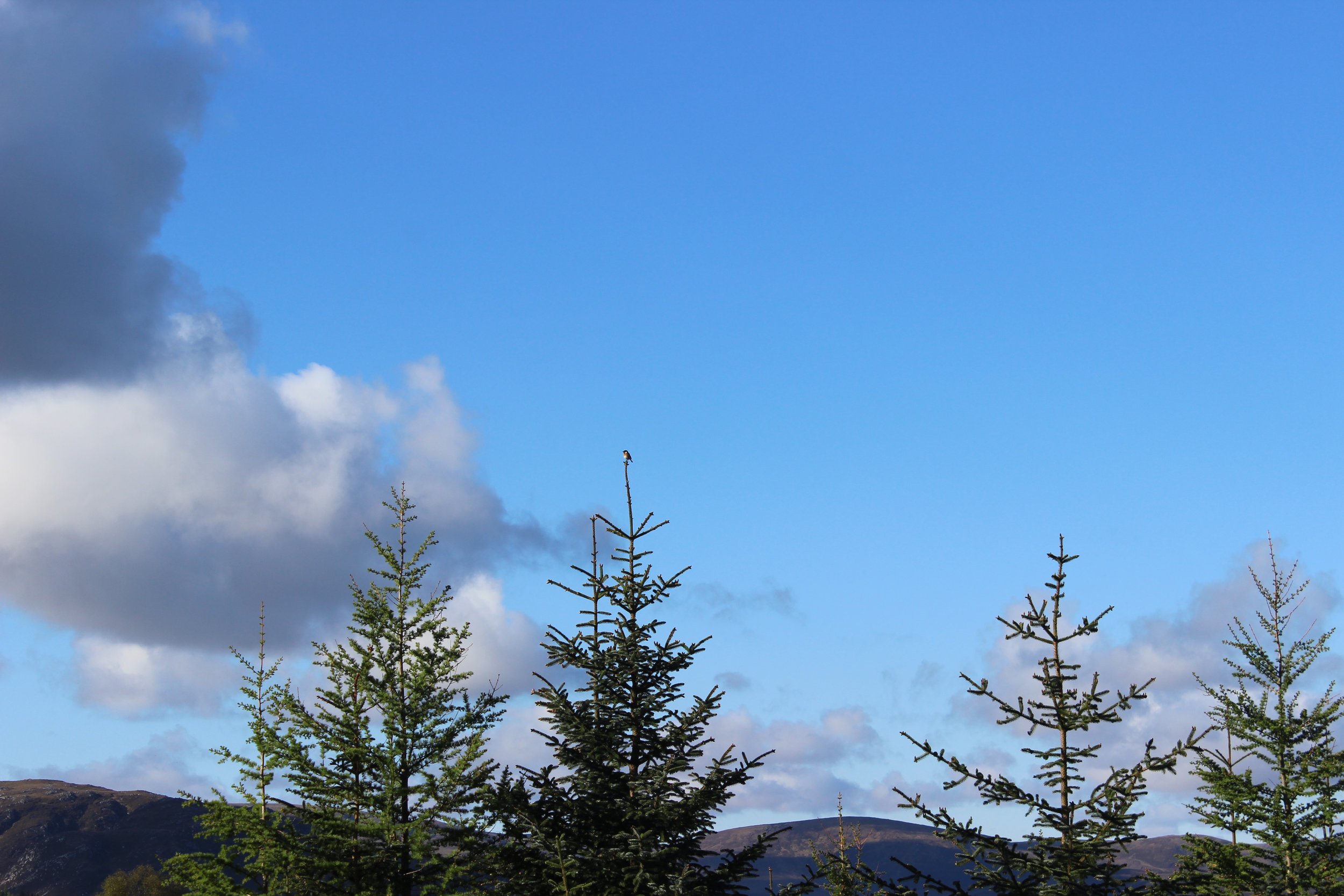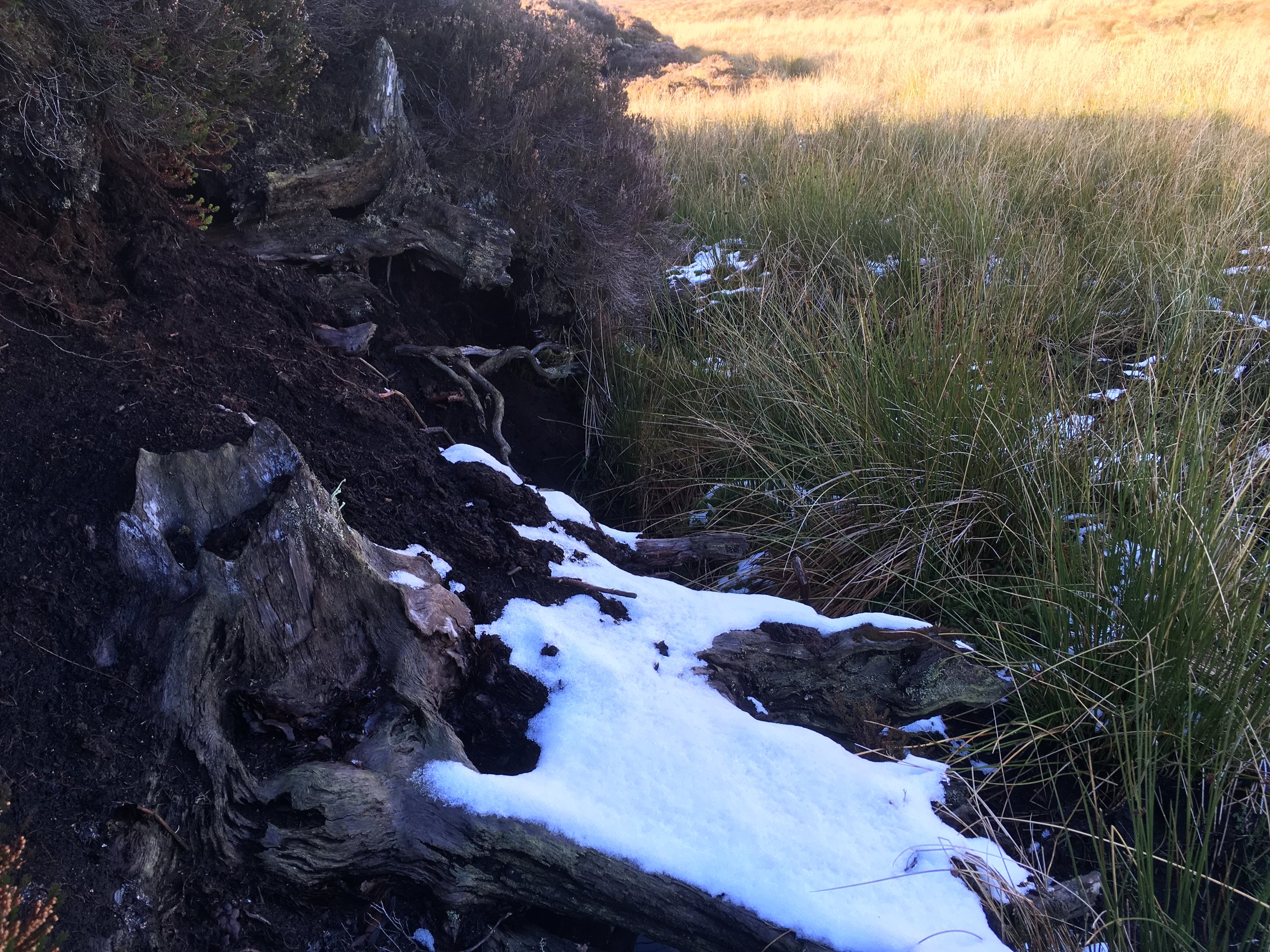English summary below -
Tha seann bhaile fearainn air cùl an taighe. Feumaidh tu slighe a ghabhail tron a’ mhòintich an-diugh gus a ruigheachd. ‘S e am Baile Dubh a b’ aimn dha (Baldoo gu h-ìosal).
Latha dha robh e, feumaidh gur e suidheachadh math a bh’aig a’ Bhaile Dhubh; faisg air an abhainn, le tobair, talamh còmhnard is beagan dìon on ghaoith ‘s e ann am fasgadh a’ chnuic.
Baile Dubh/ ‘Baldoo’ is na seann slighean ann
Tha a’ chlann measail air a bhith a’ cluich ann. A’ chiad latha a chaidh sinn ann, thug sinn linn pàipear is peansail is camera. Thog sinn na dealbhan seo is rinn an tè bheag mapa de na tobhtaichean.
a’ tilleadh bhon a bhith a’ plubadaich san abhainn
bùth
mapa
spàigearan beag a’ sreap nan creag
latha eile a’ cluich ann
Cuairt gu Gleann Fireachan
Latha eile as t-samhradh ghabh sinn cuairt a Ghleann Fireachan. B’ e seo baile fearann eile, mu mhìle gu deas air a’ Bhaile Dhubh. Chì thu bàthach ann fhathast bhon rathad chùil faisg air Tòrr Darraich. Gun fhiosda dhuinn aig an àm, bha ceangal eadar na daoine a bha uair san dà àite seo.
CHUALA WIllie FORBES naidheachd aig an duine as leis an talamh an diugh, fear MAcCuithinn, gun deach am bàthach a thogail ‘s nach robh airgead aige airson an taigh an uair sin.
caob de mhullach sgràtha
Gleann Fireachan - bho Fireach: upper slope, high ground (usually barren) / barren ground (Faclair Beag/ Dwelly)
Beartas - bog a’ mhonaidh, canach, còinneach, fraoch, buidheagan is balgain-bhuachair.
Tha clàraidhean aig Tobair an Dualchais do fhear, Finlay Smith a bh’ann an Ach Bhainnearan (Achvaneran) is a bhean Jessie a’ bruidhinn ris an t-Ollamh Nicolaisen mu ainmean àite na sgìre seo. Thug iad luaidh air a’ Bhaile Dhubh seo (clàr 1; 16.20-50) ag ràdh gun robh seann bhodach, treabhaiche pòsda ‘s a theaghlach, a’ fuireach ann ri chiad chuimhne. Nam b’ urrainn dhuinn ainm a lorg, bhiodh sin againn co-dhiù.
Dh’iarr mi air nàbaidh dhomh, Anna Nic Dhòmhnaill, tè a tha eòlach air obair sloinntireachd, mo chuideachadh gus ainm a lorg. Bha beagan tàire aice leis mar a chaidh ‘Blackton‘ a thoirt air anns a’ chunntas ann an 1871 ach, co-dhiù, chaidh aic’ air.
‘S e Uilleam Mac na Clèirich ainm an duine. Phòs e Anna Nic an Tòisich à Gleann Fireachan ann an 1820.
Bha iad a’ fuireach anns a’ Bhaile Dhubh fad co-dhiù dà fhichead bliadhna. Tha e air ainmeachadh mar thuathanach le 10 acair is dà shearbhant anns na cunntaisean-sluaigh. Anns a’ Bhaile Dhubh air a’ chunntas sluaigh mu dheireadh anns a bheil luaidh air an t-àite, ann an 1871, bha a mhac, Iain, a bean aigesan is dithis de na h-oighaichean.
Seo earann den sloinntearach a rinn Anna NicDhòmhnaill.
Thàinig rud eile am bàrr, le bhith a’ cur cheistean air Willie Forbes mu na tobhtaichean seo; litir a chaidh a chur gu ruige a sheanmhair, Catherine Fhoirbheis (Nic an Tòisich) aig Beitheachan (Beachan). Bha an litir bho thè a rinn eilthireachd à Srath Narann à Sealainn Nuadh. Dh’fhàg Grace Nic an Tòisich ‘s a teaghlach uile (a h-athair, a màthair, 4 bràithrean is 2 phiuthair) Gleann Fireachan ‘s gabh iad a-null gu ruige North Island ann an 1885. Bha i 18 nuair a dh’ fhàg i.
Bha talamh torrach aca an sin is an tuathanas fhèin. ‘S an litir tha i a’ bruidhinn air a bhàrr a tha air abachadh, prìs na clòimhe is ìm is feur. Ann an Srath Narann, cha robh còir-ghabhaltais aca is talamh truagh an coimeas ris na fhuair iad thall.
Tha an ionndrainn a th’oirre airson àitichean a h-òige soilleir. Bha i ‘sna seachdadan nuair a sgrìobh i dhachaigh gu a co-ogha.
“Who is farming Achavaneran now, and Balnafoich? Oh dear now these names takes me back home again. I hope you don’t mind me asking you so many questions…. I suppose old granny Baldoo’s house is pulled down long ago it was away at the back of your place. ..”
Feumaidh gur i an ‘granny Baldoo’ seo, Anna Nic an Tòisich.
Nuair a chaidh mapa na suirbhidh ordanains seo a dhèanamh ann an 1900 (1905) bha ainm is na mullaich air falbh bho na toglaichean. Tha am Baile Dubh far a bheil ‘spring’ sgrìobhte.
am fuaran
An raon fo luachair
B’ fhiach na cuairtean, am bruidhinn is an ruamhair seo gus beagan de sgeul nan daoine ‘s am beatha làitheil a thuigsinn. Chan e làrach chudthromach a tha seo, cha tig luchd-tadhail, cha tèid sanasan a chur suas, ach tillidh sinne. ‘S e àite a th’ann a dh’innseas tomhais dhuinn mun t-strì a bhiodh aca a thighinn beò. Tha an raon fo luachair an diugh. Is toil leam na naidheachdan bheaga seo ‘s nach deach dad a sgioblachadh no a sguabadh às. Is dòcha gum faighnichd a’ chlann mu na daoine a bha ann uairegin, an nàbaidhean tro thìm, is gum faod mi beagan innse dhaibh. Seo pàirt de chruth na tìre aca - àite far am faigh macmeanmhna beagan saorsa, gabhaidh suathadh ann is streap air is dealbhan a tharraing is bothain a chluich. Dhùraig mi na h-ainmean a sgrìobhadh an seo ann an cànan na daoine bha seo. Am fear a dh’ eadar-theangaich Baldoo gu Blackton, ghabhadh e an t-iognadh!
Cha bu mhiste dhuinn tomhais de sheunadh, chan eil a seo ach sin.
Summary;
ROOTING ABOUT - OUR CLOSEST RUIN
The closest ruin to us is am Baile Dubh / Baldoo on the early OS map.
Its not an official heritage site but it is a quiet place that speaks of the past. It is a landscape and environment of survival - a heritage born of a struggle to maintain a life. This is a place of small and overlooked histories.
I have a poster on how to maintain local distinctiveness by the group Common Ground which I love. Two of their manifesto ideas are;
“Reveal the past. Decay is an important process. Don’t tidy things up so much that the layers of history and that reclaimed by nature are obliterated - let continuity show.”
“Take the fingerprint of the place - forget words such as resource, site, customers and the public. Abstractions lead us a stray. Think and talk about places and people”
The children like to play at Am Baile Dubh - we took photos and the wee one drew a map of the stones. Another day in the summer we went a walk out to Gleann Fireachan (diminutive form of fireach; hill, moor, high barren ground/ upper slope) another ruin a mile to the South of Am Baile Dubh. We didn’t know at the time but there was a link between the people who were once in these two places.
Tobair an Dualchais / Kist o Riches, the online archive of recordings from the School of Scottish Studies, have a recording of a Jimmy Fraser and his wife Jessie who were in Ach Bhainnearan (Achvaneran) (track 1, 16.10). In a conversation about place names with Professor Nicolaisen he mentions a married ploughman who was at Am Baile Dubh to his first memory. If there was a way to have his name, I’d like that and Anna MacDonald, a neighbour and genealogist helped me.
Uilleam Mac a’ Chlèirich (William Clark) and his wife Anna Nic an Tòisich (MacKintosh) originally from Gleann Fireachan lived and farmed 10 acres for 40 years. They married on the 4th of December 1820 and had one son, Iain/ John. When the last census was done that showed people living at Am Baile Dubh in 1871, Uilleam was there with his son, his son’s second wife and 2 of his grandchildren. The place was last inhabited between 1871 and 1874/5.
I spoke to Willie Forbes about this place. He said a cousin of his MacKintosh granny had sent a letter home from New Zealand which might be of interest. Grace MacKintosh was 18 when she and her family (her mother, father, four brothers and two sisters) left Gleann Fireachan in 1885. Here they had no security of tenure and poor land, there they owned their own farm and had better ground. She was in her 70s when she wrote to ask of ‘granny Baldoo’s place’. The ‘granny Baldoo’ mentioned by Grace in this letter of 1933 was Anna Nic an Tòisich of Gleann Fireachan.
I can tell the children a bit about their neighbours through time. They can clamber about and play there and maybe grasp something of the life folk had here. They are asking to go again when the better weather comes.
We’re none the worse for some enchantment, that’s all this is.
dithis de bhràithrean Grace, Aonghas is Iain Mac an tòisich. Bha an dealbh seo a-measg dealbhan a bh’aig athair Willie Forbes.
a picture of two of Grace’s brothers, Angus and John Mackintosh. this picture was in Willie’s father’s photo album.




























































































































































